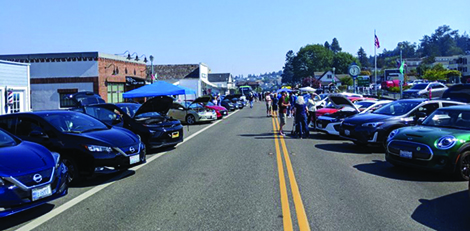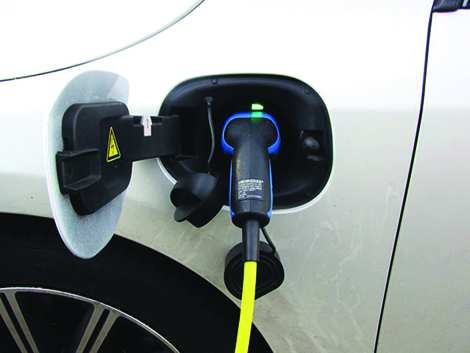
The future of car travel in Washington is looking electric.
The Evergreen state will join California in requiring auto companies to require that, starting with 2035 models, new cars have zero tailpipe emissions. Many governments are adopting similar measures. It’s a matter of planetary necessity to reduce carbon emissions, according to advocates of switching from gas to electric.
In 2020, Washington’s Legislature adopted a law directing the state Department of Ecology to adopt California vehicle emissions standards. This summer, California announced that cars with model years of 2035 or later must have zero tailpipe emissions to be sold within the state. Washington will adopt matching regulations, but the Legislature had already set a goal of its own. The transportation plan approved by the lawmakers last spring set a goal five years more aggressive: Cars and light-duty vehicles of model year 2030 or later must be electric.
The 2030 target is not a mandate but a goal, one that the state is developing a strategy to achieve. The 2035 measure would be a law and a requirement once enacted. The Department of Ecology is accepting public comment on the proposal.
“We think of the California regulation as the floor, and we’ve set a new ceiling of trying to get that done by 2030,” said Anna Lising, senior climate advisor to Washington Governor Jay Inslee.
Electric transportation has been an ongoing priority for Inslee, including cars, buses, ferries, and rail. Lising has been instrumental in helping craft those policies. She has answers to some common questions about EVs (electric vehicles).
The town of Steilacoom, WA kicked off this year’s National Drive Electric Week with a gathering of electric car drivers on Sept. 10. Dealerships showed off new models like the Ford F-150 Lightning, and locals brought 28 different EV models to show off. Photos courtesy of Steilacoom Mayor Dick Muri.
Washington and California have just committed to electrify personal vehicles. Why now?
Lising: This goal wasn’t set overnight — it’s been years in the making. There’s a sense of urgency. Transportation is the number-one contributor of carbon emissions in Washington, and our biggest opportunity to make a difference. EVs have entered mass-market production and they are increasingly affordable. We’re at a tipping point. The threat of climate change is clear. EVs have matured. The private sector is on board. Washington’s leadership has helped the state, the nation, and the world get where we are now.
Electric cars may be zero-emissions, but not zero-footprint. Are they definitively better for the environment?
Absolutely. EVs leave a much smaller carbon footprint than vehicles with internal combustion engines. Once built, they don’t keep consuming non-renewable resources and belching carbon emissions. In a state like Washington with such clean electricity, EVs are even better. That said, there’s more work to be done to ensure batteries can be reused and recycled. Reduced emissions will also improve air quality near roadways. Low-income communities and communities of color are disproportionately located in polluted areas, diminishing life expectancy. EVs are better for the environment, and our communities and people.
President Joe Biden sits at the wheel of a new Cadillac EV concept at the 2022 Detroit Auto Show. Recent federal legislation has invested more than $135 billion to advance electric transportation. Photo courtesy of The White House.
EVs accounted for 3.2 percent of light vehicles sold in 2021. What will change by 2030 for EVs to become the popular choice?
EV market share is accelerating — fast. EV registration in Washington has increased nearly fivefold in five years. This past July, 8 percent of new vehicles registered in Washington were battery-powered. New models are shipping and price parity is improving. The most encouraging sign is carmakers leaning in. New models by Audi, Cadillac, Chevrolet, Genesis, GMC, Honda, Hyundai, Jeep, Kia, Lexus, Lincoln, Mercedes-Benz, Nissan, Tesla, Toyota, and Volkswagen are coming this year. Your favorite car will soon be electric.
Cost is key to any car shopper. How do EVs compare in price and cost of ownership?
EVs are cheaper to own in the long term — especially factoring Washington’s affordable electricity. Electricity in Seattle is about 29 percent cheaper than the national average. Fuel savings can quickly overcome a sticker price premium. EVs have a higher sticker price right now. Clean technology cant be exclusive to wealthy urbanites. That’s why a renewed $7,500 federal tax credit for the purchase of a qualifying EV is important. That’s why the sales tax exemption in Washington is important.
If it breaks, who can fix it? Are EVs reliable?
People love their EVs — an EV manufacturer took the top spot for consumer satisfaction in a recent study by Consumer Reports. EVs have fewer moving parts, which means fewer things that can break down and fewer pieces to maintain. You might also be able to fix a problem with a simple firmware update. EVs still need tire changes. They rely on hydraulic brakes. You still need to take care of them. Some manufacturers might be more reliable than others, but there are advantages to fewer moving parts.
Weather has stressed electrical grids in California and Texas. Is Washington’s grid ready to charge the population’s personal vehicles?
Research by the federal government projects that the nation’s grid is ready for EVs. State forecasting shows that our grid can support EVs through the next decade. We’re actively working with utilities to build new clean energy in the state to meet growing demand. A new wind farm at Rattlesnake Flat is generating 160 megawatts and it created 250 jobs. More than 40 solar farm projects are proposed across the state.
China is out-building America in the production of EVs. Will EV adoption benefit domestic industry?
EVs create jobs. Their “fuel” is made by Washingtonians operating our wind and solar farms, clean power plants, and utilities. Manufacturers like Kenworth are building electric trucks here already. Nationally, the Inflation Reduction Act established incentives for domestic EV manufacture. Lithium is being processed in Nevada. Cars, batteries, and other components can and will be made in America.
Few enjoy 240-volt service near their parking spot. What measures may help the average driver charge overnight?
Everyone should have access to cleaner cars and the means to charge them. Our top priorities include rural distribution, chargers serving multi-family housing, community charging locations, charging to serve low-income residents, and charging along residential streets. We’re working with regional housing authorities to install chargers in lower-income housing developments. We’re also working on “right to charge” laws that prevent landlords and HOAs from prohibiting charging. As we work towards mass adoption, we want everyone to have a place to charge.
Fast chargers seem few and far between. How will future charging infrastructure be distributed?
Right now, the private sector has built chargers where profitable. That hasn’t been good enough. The federal Infrastructure and Jobs Act allocated funding for states to install fast charging stations every 50 miles along highways. The state received $71 million from the National Electric Vehicle Infrastructure Program — at least 40 percent of that prioritizes rural and disadvantaged communities. The state Department of Transportation is launching a mapping tool that shows where chargers are going, and where they’re needed. Washingtonians can use it to suggest charging locations in their communities.
Chargers often require different apps, adapters, and payment methods. Will drivers have to hunt for compatible chargers?
Many Washingtonians are underbanked. They may not have tap-to-pay cards or digital payment accounts. Likewise, your native language should not be a barrier. The state Department of Agriculture is working on rules that require payment and language accessibility. Finally, charging hardware must be universal. This is less of an issue than it used to be. Charging standards are consolidating and federal funding requires interoperability. State-funded stations will meet the Level 2 standard at minimum, and most federally-funded stations will support fast charging.
Are EVs ready for the demands of daily driving and long commutes?
Drivers with gas-powered cars seldom leave home with a full tank. Most EV drivers charge overnight and leave home topped off. Federal research shows that only 5 percent of trips exceed 30 miles. The average commuter drives under 15 miles to work. The typical range of a modern EV is over 200 miles. Range improves with each generation of EVs. Additionally, more charging stations are popping up. You’ll see more soon thanks to funding from both the federal government and our state legislature. Not so long from now, chargers will be operating all over the place.
